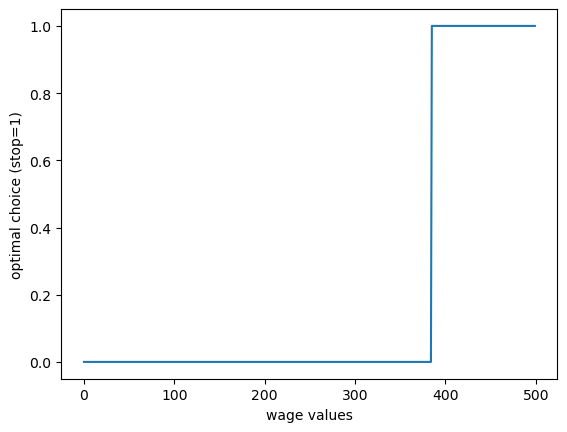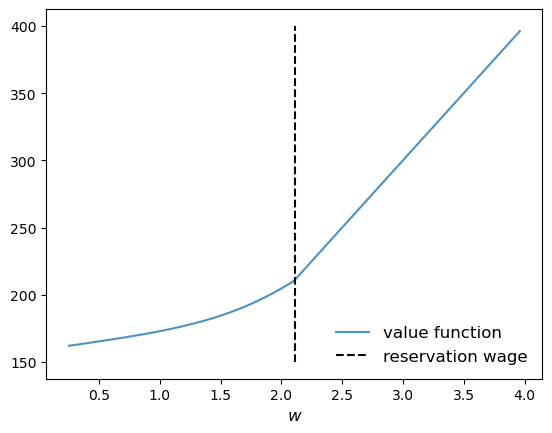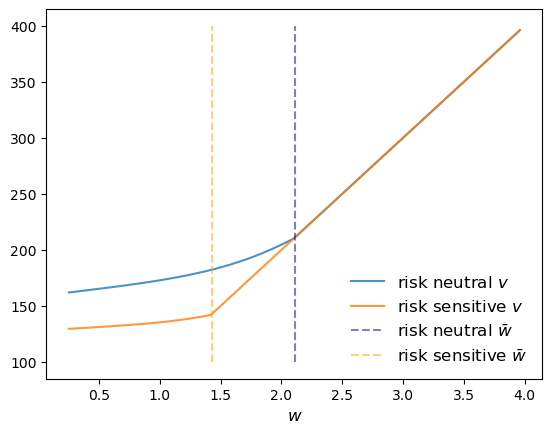10. Job Search#
GPU
This lecture was built using a machine with JAX installed and access to a GPU.
To run this lecture on Google Colab, click on the “play” icon top right, select Colab, and set the runtime environment to include a GPU.
To run this lecture on your own machine, you need to install Google JAX.
In this lecture we study a basic infinite-horizon job search problem with Markov wage draws
Note
For background on infinite horizon job search see, e.g., DP1.
The exercise at the end asks you to add risk-sensitive preferences and see how the main results change.
In addition to what’s in Anaconda, this lecture will need the following libraries:
!pip install quantecon
Show code cell output
Requirement already satisfied: quantecon in /home/runner/miniconda3/envs/quantecon/lib/python3.12/site-packages (0.8.0)
Requirement already satisfied: numba>=0.49.0 in /home/runner/miniconda3/envs/quantecon/lib/python3.12/site-packages (from quantecon) (0.60.0)
Requirement already satisfied: numpy>=1.17.0 in /home/runner/miniconda3/envs/quantecon/lib/python3.12/site-packages (from quantecon) (1.26.4)
Requirement already satisfied: requests in /home/runner/miniconda3/envs/quantecon/lib/python3.12/site-packages (from quantecon) (2.32.3)
Requirement already satisfied: scipy>=1.5.0 in /home/runner/miniconda3/envs/quantecon/lib/python3.12/site-packages (from quantecon) (1.13.1)
Requirement already satisfied: sympy in /home/runner/miniconda3/envs/quantecon/lib/python3.12/site-packages (from quantecon) (1.13.2)
Requirement already satisfied: llvmlite<0.44,>=0.43.0dev0 in /home/runner/miniconda3/envs/quantecon/lib/python3.12/site-packages (from numba>=0.49.0->quantecon) (0.43.0)
Requirement already satisfied: charset-normalizer<4,>=2 in /home/runner/miniconda3/envs/quantecon/lib/python3.12/site-packages (from requests->quantecon) (3.3.2)
Requirement already satisfied: idna<4,>=2.5 in /home/runner/miniconda3/envs/quantecon/lib/python3.12/site-packages (from requests->quantecon) (3.7)
Requirement already satisfied: urllib3<3,>=1.21.1 in /home/runner/miniconda3/envs/quantecon/lib/python3.12/site-packages (from requests->quantecon) (2.2.3)
Requirement already satisfied: certifi>=2017.4.17 in /home/runner/miniconda3/envs/quantecon/lib/python3.12/site-packages (from requests->quantecon) (2024.8.30)
Requirement already satisfied: mpmath<1.4,>=1.1.0 in /home/runner/miniconda3/envs/quantecon/lib/python3.12/site-packages (from sympy->quantecon) (1.3.0)
We use the following imports.
import matplotlib.pyplot as plt
import quantecon as qe
import jax
import jax.numpy as jnp
from collections import namedtuple
jax.config.update("jax_enable_x64", True)
10.1. Model#
We study an elementary model where
jobs are permanent
unemployed workers receive current compensation
the horizon is infinite
an unemployment agent discounts the future via discount factor
10.1.1. Set up#
At the start of each period, an unemployed worker receives wage offer
To build a wage offer process we consider the dynamics
where
We then discretize this wage process using Tauchen’s method to produce a stochastic matrix
Successive wage offers are drawn from
10.1.2. Rewards#
Since jobs are permanent, the return to accepting wage offer
The Bellman equation is
We solve this model using value function iteration.
10.2. Code#
Let’s set up a namedtuple to store information needed to solve the model.
Model = namedtuple('Model', ('n', 'w_vals', 'P', 'β', 'c'))
The function below holds default values and populates the namedtuple.
def create_js_model(
n=500, # wage grid size
ρ=0.9, # wage persistence
ν=0.2, # wage volatility
β=0.99, # discount factor
c=1.0, # unemployment compensation
):
"Creates an instance of the job search model with Markov wages."
mc = qe.tauchen(n, ρ, ν)
w_vals, P = jnp.exp(mc.state_values), jnp.array(mc.P)
return Model(n, w_vals, P, β, c)
Let’s test it:
model = create_js_model(β=0.98)
model.c
1.0
model.β
0.98
model.w_vals.mean()
Array(1.34861482, dtype=float64)
Here’s the Bellman operator.
@jax.jit
def T(v, model):
"""
The Bellman operator Tv = max{e, c + β E v} with
e(w) = w / (1-β) and (Ev)(w) = E_w[ v(W')]
"""
n, w_vals, P, β, c = model
h = c + β * P @ v
e = w_vals / (1 - β)
return jnp.maximum(e, h)
The next function computes the optimal policy under the assumption that
The policy takes the form
Here
@jax.jit
def get_greedy(v, model):
"Get a v-greedy policy."
n, w_vals, P, β, c = model
e = w_vals / (1 - β)
h = c + β * P @ v
σ = jnp.where(e >= h, 1, 0)
return σ
Here’s a routine for value function iteration.
def vfi(model, max_iter=10_000, tol=1e-4):
"Solve the infinite-horizon Markov job search model by VFI."
print("Starting VFI iteration.")
v = jnp.zeros_like(model.w_vals) # Initial guess
i = 0
error = tol + 1
while error > tol and i < max_iter:
new_v = T(v, model)
error = jnp.max(jnp.abs(new_v - v))
i += 1
v = new_v
v_star = v
σ_star = get_greedy(v_star, model)
return v_star, σ_star
10.3. Computing the solution#
Let’s set up and solve the model.
model = create_js_model()
n, w_vals, P, β, c = model
v_star, σ_star = vfi(model)
Starting VFI iteration.
Here’s the optimal policy:
fig, ax = plt.subplots()
ax.plot(σ_star)
ax.set_xlabel("wage values")
ax.set_ylabel("optimal choice (stop=1)")
plt.show()
We compute the reservation wage as the first
stop_indices = jnp.where(σ_star == 1)
stop_indices
(Array([385, 386, 387, 388, 389, 390, 391, 392, 393, 394, 395, 396, 397,
398, 399, 400, 401, 402, 403, 404, 405, 406, 407, 408, 409, 410,
411, 412, 413, 414, 415, 416, 417, 418, 419, 420, 421, 422, 423,
424, 425, 426, 427, 428, 429, 430, 431, 432, 433, 434, 435, 436,
437, 438, 439, 440, 441, 442, 443, 444, 445, 446, 447, 448, 449,
450, 451, 452, 453, 454, 455, 456, 457, 458, 459, 460, 461, 462,
463, 464, 465, 466, 467, 468, 469, 470, 471, 472, 473, 474, 475,
476, 477, 478, 479, 480, 481, 482, 483, 484, 485, 486, 487, 488,
489, 490, 491, 492, 493, 494, 495, 496, 497, 498, 499], dtype=int64),)
res_wage_index = min(stop_indices[0])
res_wage = w_vals[res_wage_index]
Here’s a joint plot of the value function and the reservation wage.
10.4. Exercise#
Exercise 10.1
In the setting above, the agent is risk-neutral vis-a-vis future utility risk.
Now solve the same problem but this time assuming that the agent has risk-sensitive preferences, which are a type of nonlinear recursive preferences.
The Bellman equation becomes
When
Solve the model when
Try to interpret your result.
You can start with the following code:
RiskModel = namedtuple('Model', ('n', 'w_vals', 'P', 'β', 'c', 'θ'))
def create_risk_sensitive_js_model(
n=500, # wage grid size
ρ=0.9, # wage persistence
ν=0.2, # wage volatility
β=0.99, # discount factor
c=1.0, # unemployment compensation
θ=-0.1 # risk parameter
):
"Creates an instance of the job search model with Markov wages."
mc = qe.tauchen(n, ρ, ν)
w_vals, P = jnp.exp(mc.state_values), mc.P
P = jnp.array(P)
return RiskModel(n, w_vals, P, β, c, θ)
Now you need to modify T and get_greedy and then run value function iteration again.
Solution to Exercise 10.1
RiskModel = namedtuple('Model', ('n', 'w_vals', 'P', 'β', 'c', 'θ'))
def create_risk_sensitive_js_model(
n=500, # wage grid size
ρ=0.9, # wage persistence
ν=0.2, # wage volatility
β=0.99, # discount factor
c=1.0, # unemployment compensation
θ=-0.1 # risk parameter
):
"Creates an instance of the job search model with Markov wages."
mc = qe.tauchen(n, ρ, ν)
w_vals, P = jnp.exp(mc.state_values), mc.P
P = jnp.array(P)
return RiskModel(n, w_vals, P, β, c, θ)
@jax.jit
def T_rs(v, model):
"""
The Bellman operator Tv = max{e, c + β R v} with
e(w) = w / (1-β) and
(Rv)(w) = (1/θ) ln{E_w[ exp(θ v(W'))]}
"""
n, w_vals, P, β, c, θ = model
h = c + (β / θ) * jnp.log(P @ (jnp.exp(θ * v)))
e = w_vals / (1 - β)
return jnp.maximum(e, h)
@jax.jit
def get_greedy_rs(v, model):
" Get a v-greedy policy."
n, w_vals, P, β, c, θ = model
e = w_vals / (1 - β)
h = c + (β / θ) * jnp.log(P @ (jnp.exp(θ * v)))
σ = jnp.where(e >= h, 1, 0)
return σ
def vfi(model, max_iter=10_000, tol=1e-4):
"Solve the infinite-horizon Markov job search model by VFI."
print("Starting VFI iteration.")
v = jnp.zeros_like(model.w_vals) # Initial guess
i = 0
error = tol + 1
while error > tol and i < max_iter:
new_v = T_rs(v, model)
error = jnp.max(jnp.abs(new_v - v))
i += 1
v = new_v
v_star = v
σ_star = get_greedy_rs(v_star, model)
return v_star, σ_star
model_rs = create_risk_sensitive_js_model()
n, w_vals, P, β, c, θ = model_rs
v_star_rs, σ_star_rs = vfi(model_rs)
Starting VFI iteration.
Let’s plot the results together with the original risk neutral case and see what we get.
stop_indices = jnp.where(σ_star_rs == 1)
res_wage_index = min(stop_indices[0])
res_wage_rs = w_vals[res_wage_index]
fig, ax = plt.subplots()
ax.plot(w_vals, v_star, alpha=0.8, label="risk neutral $v$")
ax.plot(w_vals, v_star_rs, alpha=0.8, label="risk sensitive $v$")
ax.vlines((res_wage,), 100, 400, ls='--', color='darkblue',
alpha=0.5, label=r"risk neutral $\bar w$")
ax.vlines((res_wage_rs,), 100, 400, ls='--', color='orange',
alpha=0.5, label=r"risk sensitive $\bar w$")
ax.legend(frameon=False, fontsize=12, loc="lower right")
ax.set_xlabel("$w$", fontsize=12)
plt.show()
The figure shows that the reservation wage under risk sensitive preferences (RS
This makes sense – the agent does not like risk and hence is more inclined to accept the current offer, even when it’s lower.


